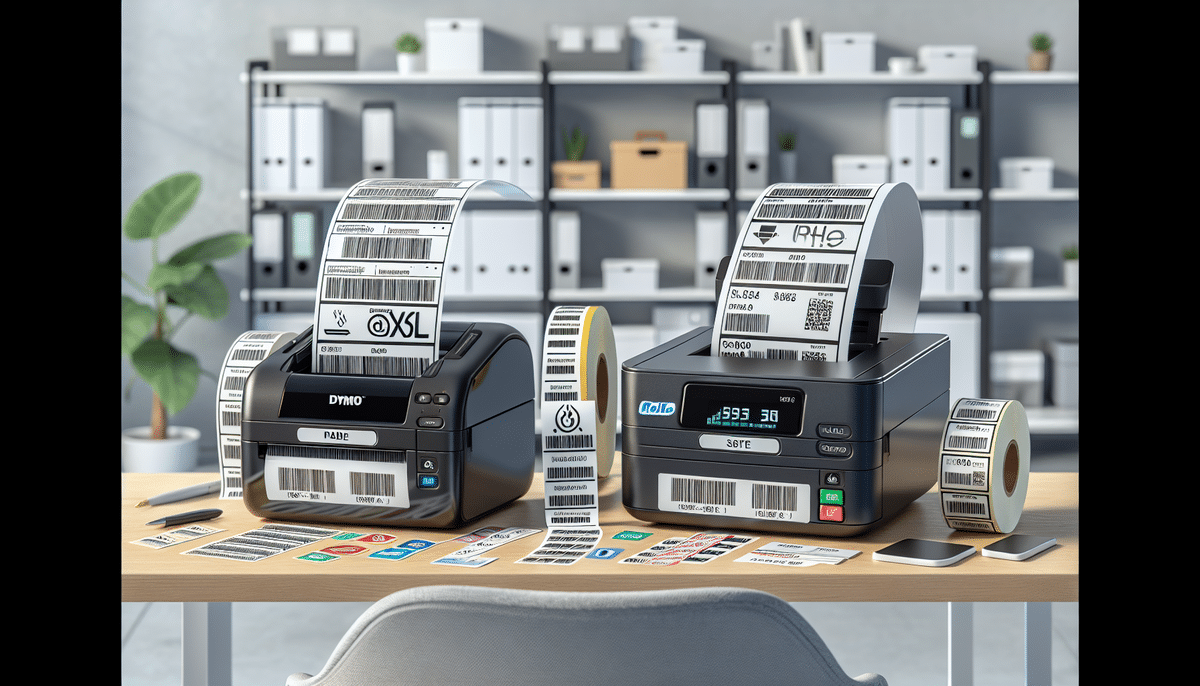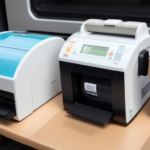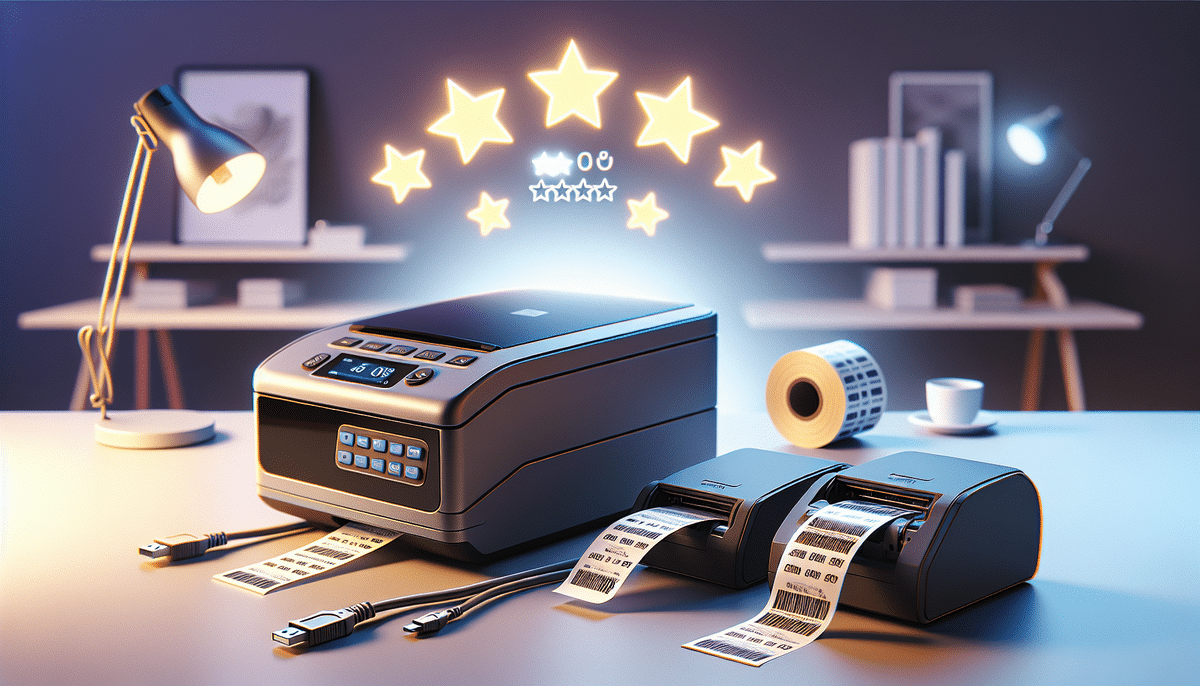DYMO LabelWriter 4XL vs Rollo Label Printer: An In-Depth Comparison
Choosing the right label printer is essential for businesses that depend on efficient and high-quality label production. Two of the leading options in the market are the DYMO LabelWriter 4XL and the Rollo Label Printer. This comprehensive comparison explores the key features, performance metrics, and user feedback to help you determine which printer best suits your business needs.
Key Features
DYMO LabelWriter 4XL
- Printing Technology: Utilizes thermal printing to produce labels up to 4 inches wide at 300 dpi, ensuring sharp and clear prints without the need for ink or toner.
- Speed: Capable of printing up to 53 labels per minute, making it ideal for high-volume printing tasks.
- Compatibility: Supports integration with popular shipping platforms such as USPS, UPS, and FedEx, allowing direct printing of shipping labels.
- Software: Includes DYMO Label Software for creating custom labels with graphics, logos, and barcodes.
- Energy Efficiency: Features an auto-sleep mode to conserve energy and prolong the printer’s lifespan.
Rollo Label Printer
- Printing Technology: Employs thermal direct printing to produce labels up to 4.1 inches wide at 203 dpi, suitable for various label types.
- Durability: Built to handle heavy usage with a lifespan of up to 500,000 labels.
- Connectivity: Offers multiple connectivity options including USB and Ethernet, enhancing flexibility.
- Software: Compatible with multiple shipping platforms and integrates seamlessly with e-commerce solutions.
- Operating System Compatibility: Compatible with both Windows and Mac, catering to diverse business environments.
Performance Comparison
Print Quality
Both the DYMO LabelWriter 4XL and the Rollo Label Printer deliver high-quality prints, but there are notable differences:
- Resolution: DYMO offers a higher resolution of 300 dpi compared to Rollo’s 203 dpi, resulting in sharper and more detailed labels.
- Label Material Compatibility: DYMO supports a broader range of materials, including heat shrink tubes and warehouse labels, which can enhance print quality for specific applications.
- Print Speed Impact: Rollo’s faster print speed of 150mm/s may slightly compromise print quality under heavy loads, whereas DYMO maintains consistent quality at 53 labels per minute.
Speed
When evaluating print speed:
- DYMO LabelWriter 4XL: Prints up to 53 labels per minute, suitable for businesses with moderate labeling needs.
- Rollo Label Printer: Capable of printing at speeds up to 150mm/s, making it ideal for high-volume label printing.
While Rollo offers faster printing, DYMO provides consistent quality, which may be more critical for certain business applications.
Design and Usability
Size and Design
Both printers boast compact and sleek designs, fitting seamlessly into any office setup:
- DYMO LabelWriter 4XL: Dimensions of 7.7 x 5.3 x 7.3 inches and weighs 2.2 pounds.
- Rollo Label Printer: More compact at 7.7 x 3 x 3.3 inches and also weighs 2.2 pounds.
Rollo’s smaller footprint may be advantageous for businesses with limited workspace.
Ease of Use
User-friendliness is essential for efficient operations:
- DYMO LabelWriter 4XL: Features a straightforward interface with multiple software options like DYMO Connect and DYMO Stamps.
- Rollo Label Printer: Offers intuitive software with easy setup processes and straightforward label design tools.
DYMO provides versatile connectivity options, including USB and Ethernet, whereas Rollo offers USB with additional wireless options.
Connectivity and Software
- DYMO LabelWriter 4XL: Supports USB and Ethernet connections, providing flexibility in various network environments.
- Rollo Label Printer: Offers USB connectivity with options for wireless setups through third-party solutions, enabling more mobile and on-the-go label printing.
Both printers support robust connectivity options, but Rollo’s potential for wireless integration offers unique advantages for mobile operations.
Software Integration
Effective software enhances the labeling process:
- DYMO LabelWriter 4XL: Includes DYMO Label Software, which allows customization with graphics, logos, barcodes, and integrates with Microsoft Excel for bulk data imports.
- Rollo Label Printer: Compatible with multiple shipping platforms and e-commerce solutions, facilitating seamless label creation and order tracking.
Both printers support third-party software such as UPS WorldShip, enhancing their versatility.
Cost Analysis
Budget considerations are crucial:
- DYMO LabelWriter 4XL: Priced around $200, offering higher resolution and versatile label compatibility.
- Rollo Label Printer: Slightly more affordable at approximately $180, with faster printing speeds.
The investment in DYMO yields benefits in print quality and label variety, while Rollo provides cost savings and speed.
User Feedback
Customer feedback provides valuable insights:
- DYMO LabelWriter 4XL: Holds an average rating of 4.4 out of 5 stars on Amazon, with users highlighting its speed, print quality, and user-friendly interface.
- Rollo Label Printer: Achieves an average rating of 4.5 out of 5 stars on Amazon, praised for its durability, excellent print quality, and versatile connectivity options.
Which Printer is Right for Your Business?
The decision between the DYMO LabelWriter 4XL and the Rollo Label Printer hinges on your specific business requirements:
- Choose DYMO LabelWriter 4XL if:
- You need high-resolution labels for professional presentations.
- Your business requires compatibility with a wide range of label types and shipping platforms.
- Energy efficiency and long-term reliability are priorities.
- Choose Rollo Label Printer if:
- You demand high-speed label printing for large volumes.
- You require versatile connectivity, including potential wireless printing capabilities.
- Cost-effectiveness is a significant factor.
Tips for Choosing the Right Label Printer
- Assess Your Printing Volume: Determine the number of labels you print daily to ensure the printer meets your capacity needs.
- Evaluate Label Requirements: Consider the types and sizes of labels you need, including any specialized materials.
- Consider Connectivity Needs: Choose a printer with the appropriate connectivity options that align with your business infrastructure.
- Software Compatibility: Ensure the printer’s software integrates smoothly with your existing systems and platforms.
- Budget Constraints: Balance initial costs with long-term benefits such as durability and efficiency.
By carefully evaluating these factors, you can select a label printer that enhances your business operations and provides a solid return on investment.








